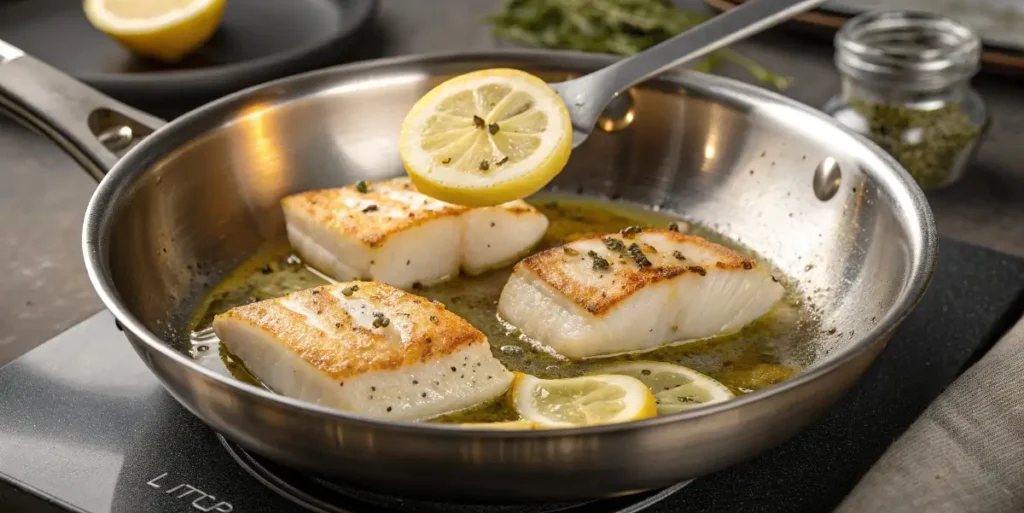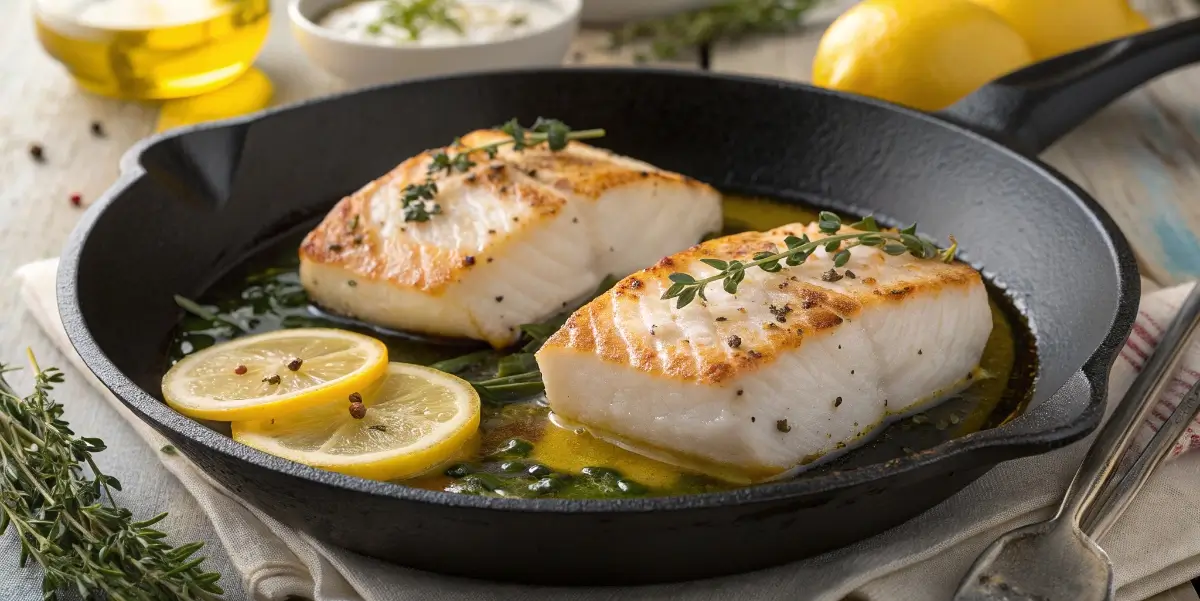Halibut Cheeks Recipe – The Ultimate Guide to Perfectly Tender Seafood Delight
Cooking seafood can be intimidating, but halibut cheeks make it surprisingly easy and delicious. Known for their soft, buttery texture and naturally sweet flavor, these delicate morsels are often compared to the tenderness of scallops. This halibut cheeks recipe guide will walk you through how to choose, cook, and serve this underappreciated seafood gem like a pro.
Learn more about easy fish food recipes to try at home for more seafood inspiration.
Table of Contents
Introduction to Halibut Cheeks
What Are Halibut Cheeks?
Halibut cheeks are the small, round muscles found on the fish’s face, right below its eyes. They’re the most tender part of the halibut, similar to scallops in texture but with a mild, clean flavor that pairs well with buttery sauces and herbs. Because each halibut yields only a few cheeks, they’re considered a premium cut among seafood lovers.
Why Halibut Cheeks Are Considered a Delicacy
Unlike traditional halibut fillets, cheeks have a silky and almost melt-in-your-mouth consistency. Their sweetness stands out even with simple seasoning like lemon, salt, and olive oil. Chefs and home cooks alike prize them for their versatility—pan-seared, grilled, or baked, they always turn out impressive. Check out irresistible salmon belly recipes if you love rich, flavorful seafood.
The Unique Texture and Flavor Profile
The texture of halibut cheeks is tender yet firm, offering a light, buttery bite that doesn’t flake apart like a fillet. When cooked correctly, they deliver a subtle sweetness and moist interior that captures the essence of fresh ocean flavor. For those who enjoy mild-tasting seafood such as cod or halibut fillet, cheeks are an upgrade worth trying. Discover great ideas like honey garlic glazed salmon for more flavorful seafood dishes.
Nutritional Benefits of Halibut Cheeks
Protein, Vitamins, and Omega-3 Content
Halibut cheeks aren’t just tasty—they’re packed with nutrition. A single serving delivers high-quality lean protein, essential for muscle repair and energy. They’re also rich in omega-3 fatty acids, which support heart and brain health. You’ll find important vitamins like B6, B12, and D, plus minerals such as magnesium and selenium that help boost immunity and metabolism.
Comparing Halibut Cheeks vs. Halibut Fillets
When comparing halibut cheeks and fillets, cheeks win in tenderness and flavor. While fillets are flaky and meaty, cheeks are soft and delicate, perfect for light pan-searing or quick sautéing. Both cuts share similar nutrition, but the cheeks retain more moisture and healthy fats due to their compact structure. Learn more about delicious smoked salmon brine recipes for another omega-3–rich meal idea.
Health Benefits of Including Halibut in Your Diet
Including halibut cheeks in your diet supports a healthy heart, glowing skin, and improved brain function. Since they’re naturally low in saturated fats and calories, they make an excellent choice for balanced eating. The combination of omega-3s and lean protein keeps you full longer while supporting overall wellness. For other healthy seafood ideas, don’t miss our air fryer frozen salmon guide.
How to Choose and Prepare Fresh Halibut Cheeks

Tips for Selecting Fresh Halibut-Cheeks at the Market
When buying halibut cheeks, freshness is key. Look for pieces that are moist, firm, and slightly translucent. The flesh should have a clean, ocean-fresh scent—never fishy or sour. Avoid cheeks that appear dry or discolored. If buying frozen, choose vacuum-sealed portions with minimal ice crystals for the best results.
Learn more about delicious crab brulee recipes for another seafood delicacy you can prepare at home.
Proper Cleaning and Trimming Techniques
Before cooking, rinse the halibut cheeks under cold water and pat them completely dry. Remove any remaining connective tissue or skin with a sharp knife for a smooth texture. Keeping the cheeks dry ensures a perfect golden-brown sear when cooking—essential for flavor and presentation.
How to Store Halibut Cheeks Before Cooking
If you’re not cooking immediately, refrigerate the halibut cheeks in an airtight container for up to two days. For longer storage, freeze them flat in sealed bags to preserve texture. Always thaw in the refrigerator overnight rather than at room temperature to maintain quality and flavor.
Looking for inspiration? Try easy fish food recipes to try at home for more smart seafood storage and cooking ideas.
Cooking Methods for the Perfect Halibut Cheeks Recipe
Pan-Seared Halibut Cheeks (Step-by-Step Method)
Pan-searing is the most popular way to bring out the buttery tenderness of halibut cheeks.
Step 1: Pat the cheeks dry and season with salt, pepper, and a touch of lemon zest.
Step 2: Heat butter and olive oil in a skillet over medium-high heat.
Step 3: Add the halibut cheeks and sear each side for 2–3 minutes until golden brown.
Step 4: Finish with a squeeze of fresh lemon juice and minced parsley.
The result? Crispy edges with a soft, melt-in-your-mouth center.
Grilled Halibut Cheeks for a Smoky Twist
If you prefer a smoky aroma, grilling halibut cheeks is a great option. Brush lightly with olive oil and season with sea salt and garlic. Grill over medium heat for about 3 minutes per side, depending on thickness. Serve with a drizzle of herb butter or garlic aioli for extra flavor. This method enhances the natural sweetness without overpowering it.

Oven-Baked Halibut-Cheeks for a Healthier Option
For a low-fat meal, oven-baked halibut cheeks are ideal. Preheat your oven to 400°F (200°C). Place cheeks on a lined baking sheet, drizzle with olive oil, and top with a sprinkle of paprika or thyme. Bake for 8–10 minutes or until opaque and flaky. The gentle heat preserves moisture and nutrients, perfect for a heart-healthy dinner.
Gordon Ramsay–Inspired Halibut Cheek Recipe
Celebrity chef Gordon Ramsay often emphasizes simplicity and precision in seafood. Following his approach, lightly season halibut cheeks with salt, pepper, and lemon. Sear them quickly in butter and baste while cooking for flavor depth. Serve over pea purée or sautéed spinach for a restaurant-worthy presentation. Don’t miss our honey garlic glazed salmon for another chef-inspired seafood dish.
Flavor Pairings and Seasoning Ideas
Best Marinades and Rubs for Halibut Cheeks
Halibut cheeks have a mild sweetness, making them ideal for light, aromatic marinades. A simple blend of olive oil, lemon juice, garlic, and dill enhances their natural flavor without overpowering it. For a bolder twist, try a soy-ginger glaze or Cajun spice rub. Let the cheeks marinate for 15–20 minutes before cooking to allow the flavors to absorb evenly.
| Marinade Type | Key Ingredients | Best For |
|---|---|---|
| Lemon Herb | Olive oil, lemon zest, dill | Pan-searing |
| Garlic Butter | Butter, garlic, parsley | Grilling |
| Asian Fusion | Soy sauce, ginger, sesame oil | Baking |
Don’t miss our delicious smoked salmon brine recipe for more marinade inspiration that complements seafood flavors beautifully.
Side Dishes That Complement Halibut Cheeks
Pairing your halibut cheeks recipe with the right sides brings balance to your meal. Try creamy mashed potatoes, roasted asparagus, or a citrus quinoa salad. For something lighter, a cucumber-dill yogurt sauce or simple arugula salad works perfectly. These sides keep the focus on the cheeks’ tender texture while adding freshness and crunch.
Wine Pairings and Sauces for a Gourmet Experience
A crisp white wine like Sauvignon Blanc or Pinot Grigio complements the mild richness of halibut-cheeks. If you prefer sauce over wine, go for lemon caper butter, garlic cream sauce, or basil pesto for an elegant touch. Looking for inspiration? Try irresistible salmon belly recipes for another luxurious seafood pairing idea.

Common Mistakes to Avoid When Cooking Halibut Cheeks
Overcooking and Texture Loss
The most common mistake when making a halibut cheeks recipe is overcooking. Because halibut-cheeks are small and delicate, they cook in just a few minutes. Overcooking turns their tender, buttery texture into something dry and chewy. Always cook them over medium heat and remove them from the pan as soon as they turn opaque and flake slightly under a fork.
Seasoning Pitfalls and How to Fix Them
Halibut cheeks have a naturally mild, sweet flavor that can be overpowered by strong spices or too much salt. Keep seasonings simple—salt, pepper, and lemon go a long way. If your dish tastes bland, finish with a drizzle of garlic butter or a squeeze of fresh citrus to bring it back to life. Check out honey garlic glazed salmon to learn how to balance sweetness and salt perfectly in seafood dishes.
Temperature and Timing Secrets
Cooking at the wrong temperature can ruin your halibut cheeks recipe. Use medium to medium-high heat for pan-searing and moderate oven temperatures (around 400°F) for baking. The cheeks should reach an internal temperature of about 130°F for ideal tenderness. A quick sear or bake ensures they stay juicy while developing a light golden crust. Learn more about easy fish food recipes to try at home for more cooking time guides.
Expert Tips for Perfect Halibut Cheeks Every Time
Chef-Approved Cooking Temperatures and Durations
For best results, cook halibut cheeks at medium to medium-high heat. Aim for an internal temperature of 130°F (54°C) for a tender, juicy center. Always preheat your pan before adding the fish to achieve that beautiful golden sear. Whether you’re pan-searing, baking, or grilling, short cooking times preserve the fish’s natural moisture and flavor.
Butter, Garlic, and Lemon Tricks for Flavor Perfection
Butter is your secret weapon for a rich halibut cheeks recipe. As the cheeks cook, baste them with melted butter infused with garlic and lemon zest. This enhances flavor while keeping the surface moist and glossy. A touch of fresh herbs—like dill, parsley, or chives—adds color and freshness. Learn more about flavor layering from our honey garlic glazed salmon guide.
Presentation and Plating Tips for Restaurant-Quality Results
Presentation matters as much as taste. Serve halibut cheeks over creamy mashed potatoes, pea purée, or a light vegetable medley. Garnish with lemon slices, microgreens, or a drizzle of herbed oil for a refined touch. The goal is to highlight the cheeks’ natural color and delicate texture. Check out easy fish food recipes to try at home for more elegant seafood plating ideas.
Conclusion and Serving Inspiration
Cooking halibut cheeks doesn’t have to be complicated. With just a few ingredients—lemon, butter, and garlic—you can create a restaurant-quality dish that highlights this delicate seafood’s natural sweetness. Whether pan-seared, grilled, or oven-baked, the key lies in timing and simplicity.
For a light dinner, serve halibut-cheeks with roasted asparagus or lemon couscous. For a richer meal, pair them with creamy mashed potatoes and a glass of white wine. This halibut-cheeks recipe is ideal for weeknight meals, date nights, or special occasions when you want something elegant yet easy to prepare.
Don’t miss our delicious smoked salmon brine recipe and irresistible salmon belly recipe for more seafood dishes to master at home.
Frequently Asked Questions (FAQs)
Are halibut cheeks good to eat?
Absolutely! Halibut cheeks are one of the most tender and flavorful parts of the fish. They’re prized for their delicate, buttery texture and mild sweetness, similar to scallops. Many chefs consider them a hidden gem because they cook quickly and absorb seasoning beautifully.
How long do you cook halibut cheeks for?
Halibut cheeks cook very fast—typically 2–3 minutes per side when pan-seared or 8–10 minutes in the oven at 400°F. The key is to cook until the flesh turns opaque and flakes easily. Overcooking can cause the meat to lose its softness.
What is the difference between halibut cheeks and halibut fillet?
Halibut cheeks come from the facial muscle of the fish, while fillets are cut from the body. Cheeks are smaller, rounder, and more tender with a buttery flavor. Fillets are larger and flakier, great for grilling or baking. Both are delicious, but the cheeks deliver a melt-in-your-mouth experience.
What is the best way to eat halibut?
The best way to eat halibut—especially the cheeks—is pan-seared in butter and served with lemon and herbs. This method highlights the fish’s natural sweetness without masking its flavor. Pair it with light sides like roasted vegetables or citrus salad for a balanced meal.
Why is halibut difficult to cook?
Halibut can be tricky because it dries out quickly when overcooked. The solution is to use gentle heat and watch the cooking time carefully. Halibut cheeks, being smaller and fattier, are easier to keep moist, making them a great choice for beginners.
How does Gordon Ramsay cook halibut?
Gordon Ramsay often pan-sears halibut in a hot skillet with butter, lemon, and herbs. He focuses on timing and basting the fish to keep it moist and flavorful. You can use the same method for halibut cheeks—quick sear, gentle butter baste, and a finish of fresh lemon juice.

